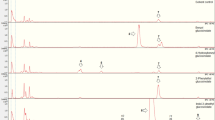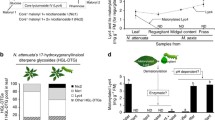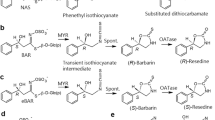Abstract
Feeding larvae of Chrysomela lapponica (Coleoptera: Chrysomelidae) acquire characteristic O-glucosides from the leaves of their food plants. The glucosides are selectively channeled from the gut to the defensive gland. Subsequent enzymatic transformations generate a blend of different defensive compounds, e.g., salicylaldehyde and two series of 2-methylbutyl and isobutyryl esters. By using systematically modified and hydrolysis-resistant thioglucosides as structural mimics of the plant-derived glucosides, e.g., salicin and its o-, m-, and p-isomers 1, 2, and 3; o-, m-, and p-cresols 5, 6, 7; along with thioglucosides of 2-phenylethanol 9 and (3Z)-hexenol 10, we demonstrated that the larvae of C. lapponica are able to sequester a broad range of structurally different thioglucosides with comparable efficiency. This sharply contrasts with the sequestration habitus previously observed in Chrysomela populi and Phratora vitellinae, which secrete almost pure salicylaldehyde and posses a highly specific transport mechanism for salicin (Kuhn et al., Proc. Natl. Acad. Sci. USA 101:13808–13813, 2004). Also, neither C. lapponica nor C. populi sequester in their gland the thioglucoside of 8-hydroxygeraniol, the mimic of the glucoside specifically transported by larvae secreting iridoid monoterpenes (Phaedon cochleariae, Gastrophysa viridula). Accordingly, leaf beetle larvae possess selective membrane carriers in their gut and their defensive systems that match the orientation of the functional groups of glucosides from their food plants probably by embedding the substrate in a network of hydrogen bonds inside the membrane carriers. The synthesis and the spectroscopic properties of the test compounds along with a comparative evaluation of the transport capabilities of larvae of C. populi and C. lapponica are described.









Similar content being viewed by others
References
Berti, N. 1968. Quelces observations sur la biologique de Phaedonia circumcincta Sahl at description des stades larvaire et nymphal. Bull. Soc. Entomol. Fr. 73:114–127.
Blum, M. S. 1981. Sequestration of plant natural products in nonsecretory structures. in Chemical Defenses of Arthropods. Academic Press, New York, pp 421–438.
Blum, M. S., Wallace, J. B., Duffield, R. M., Brand, J. M., Fales, H. M., and Sokoloski, E. A. 1978. Chrysomelidial in defensive secretion of leaf beetle Gastrophysa cyanea Melsheimer. J. Chem. Ecol. 4:47–53.
Daloze, D. and Pasteels, J. M. 1994. Isolation of 8-hydroxygeraniol-8-O-b-d-glucoside, a probable intermediate in biosynthesis of iridoid monoterpenes, from defensive secretions of Plagiodera versicolora and Gastrophysa viridula (Coleoptera, Chrysomelidae). J. Chem. Ecol. 20:2089–2097.
Duffey, S. and Scudder, G. C. E. 1972. Cardiac glycosides in North American Asclepiadaceae, a chemical basis for unpalatability in brightly coloured Hemiptera and Coleoptera. J. Insect Physiol. 18:63–78.
Dyer, L. A. and Bowers, M. D. 1996. The importance of sequestered iridoid glycosides as a defense against an ant predator. J. Chem. Ecol. 22:1527–1539.
Falconer, R. A., Jablonkai, I., and Toth, I. 1999. Efficient synthesis of thioglycosides via a Mitsunobu condensation. Tetrahedron Lett. 40:8663–8666.
Feld, B., Pasteels, J., and Boland, W. 2001. Phaedon cochleariae and Gastrophysa viridula (Coleoptera: Chrysomelidae) produce defensive iridoid monoterpenes de novo and are able to sequester glycosidically bound terpenoid precursors. Chemoecology 11:191–198.
Garb, G. 1915. The eversible glands of a Chrysomelid larva, Melasoma lapponica. J. Entomol. Zool. 8:88–97.
GROSS J. and HILKER, M. 1995. Chemoecological studies of the exocrine glandular larval secretions of two Chrysomelid species (Coleoptera): Phaedon cochleariae and Chrysomela lapponica. Chemoecology 5/6:185–189.
Hartmann, T. 1999. Chemical ecology of pyrrolizidine alkaloids. Planta 207:483–495.
Hartmann, T. and Witte, L. 1995. in S. W. Pelletier (ed.). Alkaloids: Chemical and Biological Perspectives. Pergamon, Oxford, pp. 155–233.
Hartmann, T., Theuring, C., Schmidt, J., Rahier, M., and Pasteels, J. M. 1999. Biochemical strategy of sequestration of pyrrolizidine alkaloids by adults and larvae of chrysomelid leaf beetles. J. Insect Physiol. 45:1085–1095.
Hilker, M. and Schulz, S. 1994. Composition of larval secretion of Chrysomela lapponica (Coleoptera, Chrysomelidae) and its dependence on host–plant. J. Chem. Ecol. 20:1075–1093.
Hollande, A. C. 1911. L’autohémorrhée ou le rejet du sang chez les insectes (toxicologie du sang). Arch. Anat. Microsc. 13:171–318.
Kuhn, J., Pettersson, E. M., Feld, B. K., Burse, A., Termonia, A., Pasteels, J. M., and Boland, W. 2004. Selective transport systems mediate sequestration of plant glucosides in leaf beetles: a molecular basis for adaptation and evolution. Proc. Natl. Acad. Sci. USA 101:13808–13813.
Lorenz, M., Boland, W., and Dettner, K. 1993. Biosynthesis of iridodials in the defense glands of leaf beetle larvae (Chrysomelinae). Angew. Chem. Int. Ed. 32:912–914.
Malcolm, S. B. and Brower, L. P. 1989. Evolutionary and ecological implications of cardenolide sequestration in the monarch butterfly. Experientia 45:284–295.
Meinwald, J., Jones, T. H., Eisner, T., and Hicks, K. 1977. Defense-mechanisms of arthropods. new methylcyclopentanoid terpenes from larval defensive secretion of a chrysomelid beetle (Plagiodera versicolora). Proc. Natl. Acad. Sci. USA 74:2189–2193.
Nahrstedt, A. 1996, in J. T. Romeo, J. A. Saunders, and P. Barbosa (eds.). Phytochemical diversity and redundancy in ecological interactions. Plenum Press, New York, pp. 217–230.
Nicotra, F. 1998. Modified Carbohydrates and carbohydrate analogues. in G-J. Boons (ed.). Carbohydrate Chemistry. Blackie Academic & Professional, London, pp. 384–429.
Nishida, R. 2002. Sequestration of defensive substances from plants by Lepidoptera [review]. Annu. Rev. Entomol. 47:57–92.
Oldham, N. J., Veith, M., Boland, W., and Dettner, K. 1996. Iridoid monoterpene biosynthesis in insects—evidence for a de novo pathway occurring in the defensive glands of Phaedon armoraciae (Chrysomelidae) leaf beetle larvae. Naturwissenschaften 83:470–473.
Pasteels, J. M., Braekman, J. C., Daloze, D., and Ottinger, R. 1982. Chemical defense in chrysomelid larvae and adults. Tetrahedron 38:1891–1897.
Pasteels, J. M., Rowell-Rahier, M., Braekman, J. C., and Dupont, A. 1983. Salicin from host plant as precursor of salicylaldehyde in defensive secretion of chrysomeline larvae. Physiol. Entomol. 8:307–314.
Pasteels, J. M., Duffey, S., and Rowell-Rahier, M. 1990. Toxins in chrysomelid beetles. Possible evolutionary sequence from de novo synthesis to derivation from food–plant chemicals. J. Chem. Ecol. 16:135–142.
Paterson, N. F. 1930. The bionomics and morphology of the early stage of Paraphaedon tumidulus Germ (Coleoptera, Phytophaga, Chrysomelidae). Proc. Zool. Soc. Lond. 1930:627–676.
Pavan, M. 1953. Studi sugli antibiotici e insetticidi di origine animale I. Sul principo attivo della larva di Melasoma populi L. Arch. Zool. Ital. 38:157–183.
Rothschild, M. 1973. Secondary plant substances and warning colouration in insects. in H. van Emden (ed.). Symposium of the Royal Entomological Society of London. Blackwell Scientific Publications, Oxford, pp 59–83.
Sachs, L. 1999. Angewandte Statistik. Springer, Berlin.
Schulz, S., Gross, J., and Hilker, M. 1997. Origin of the defensive secretion of the leaf beetle Chrysomela lapponica. Tetrahedron 53:9203–9212.
Søe, A. R. B., Bartram, S., Gatto, N., and Boland, W. 2004. Are terpenoids in leaf beetle larvae synthesized de novo or from plant-derived precursors? Isotopes Environ. Health Stud. 40:175–180.
Termonia, A. and Pasteels, J. M. 1999. Larval chemical defence and evolution of host shifts in Chrysomela Leaf Beetles. Chemoecology 9:13–23.
Veith, M., Lorenz, M., Boland, W., Simon, H., and Dettner, K. 1994. Biosynthesis of iridoid monoterpenes in insects—defensive secretions from larvae of leaf beetles (Coleoptera, Chrysomelidae). Tetrahedron 50:6859–6874.
Acknowledgments
We thank Angelika Berg for rearing of the insects, and Dr. A. Burse for proofreading of the manuscript. Financial support by the Fonds der Chemischen Industrie, Frankfurt a.M. and from the Belgian Fund for Join Basic Research is gratefully acknowledged.
Author information
Authors and Affiliations
Corresponding author
Electronic Supplementary Material
Below is the link to the electronic supplementary material.
ESM1
(doc 14 kb)
Rights and permissions
About this article
Cite this article
Kuhn, J., Pettersson, E.M., Feld, B.K. et al. Sequestration of Plant-Derived Phenolglucosides by Larvae of the Leaf Beetle Chrysomela lapponica: Thioglucosides as Mechanistic Probes. J Chem Ecol 33, 5–24 (2007). https://doi.org/10.1007/s10886-006-9201-1
Published:
Issue Date:
DOI: https://doi.org/10.1007/s10886-006-9201-1




